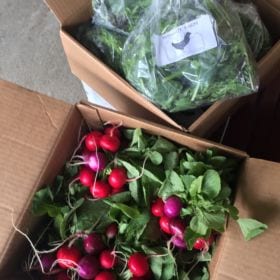
October 15, 2020 Community Stories
When Residents Needed a Hand, Northampton Delivered
Alisa Klein didn’t hesitate when asked about local people who’ve struggled to get enough food during the pandemic.
She described one mother, pulling two of her four children in a wagon, who came to a food distribution site coordinated by Grow Food Northampton.
“Every single week when she comes, she’s in tears. She is so touched and so grateful,” said Klein, executive director of the organization. “When she gets back to her apartment, she lays out all her vegetables and takes a picture of them and posts it to Facebook and talks about how Grow Food Northampton has helped her family.”

Upon learning that the city’s food pantry, Northampton Survival Center, had to close its building early on in the pandemic, Klein immediately picked up the phone and asked the Center, “What can we do?”
She knew that many people were already losing their jobs and that farmers were losing their markets.
Grow Food Northampton’s community farm manages 121 acres organically in order to help local people have enough healthy, home-grown food— while creating a more equitable food system. Its 310 community garden plots are used by people who farm for their families and neighbors (subsidies are offered to people with lower incomes). Its “Giving Garden” grows over 8,000 pounds of produce every growing season, which is donated to organizations serving local people who are food insecure.

Joining with the Survival’s Center staff and dozens of volunteers, Klein’s team quickly figured out a way to deliver and distribute fresh produce and other foods to people experiencing food insecurity: they packaged food that would sustain families for an entire week, created a staging area at a local school where folks could pick up food, and even began deliveries to 11 sites around the city for people who couldn’t get out.
A COVID-19 Response Fund grant from the Community Foundation helped Grow Food Northampton purchase produce from local farmers. It was a win-win: the farmers were in danger of having to plow under produce because they had lost many of their markets, and local residents were hungry.
Every food package created for distribution included shelf-stable products from the Survival Center’s coffers and organic produce from the local farmers.
But the community wasn’t done. They joined to deliver more for individuals and families in need:
- A children’s bookstore and local publishing house donated hundreds of books to be distributed with the food packages so kids would have enough to read during the shutdown.
- A biking group collected used bikes and—helped by different businesses—fixed the bikes for distribution to families.
- A local church prepared kits of self-care products—shampoo, soap, shaving supplies—which were handed out with food packages.
- A seafood wholesaler pitched in hundreds of pounds of flash frozen fish.
- A book illustrator gathered money from friends and filled backpacks with art supplies—paints, palettes, and chalk—for distribution to kids. He wanted to make sure kids had enough to do while home during the pandemic.
Klein called the situation “remarkable.” It sure was.
Listen to Alisa Klein describe how a grant from the COVID-19 Response Fund, hosted by the Community Foundation, helped local farmers and people who were food insecure.

